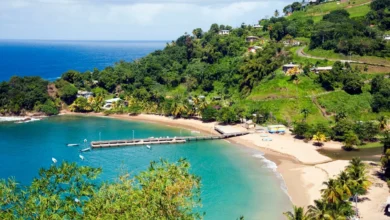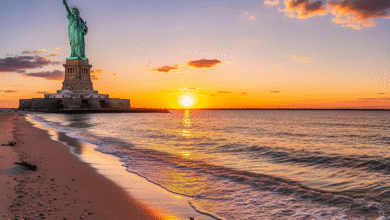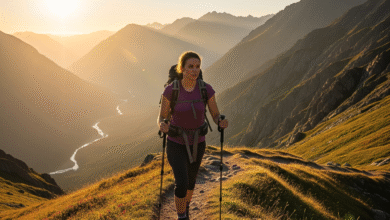This Florida National Park Is 95% Water—and You Can Kayak Through Mangroves and Scuba Dive Around Shipwrecks
That Florida national park is Biscayne National Park, located just south of Miami. It’s truly unique — about 95 % of the park’s 172,971 acres lie underwater, more than any other US national park.
Best Time to Visit
:max_bytes(150000):strip_icc():format(webp)/TAL-best-time-to-visit-BISCAYNEBAYFL0625-735bed7a42374603abb5c4dc0ea2404c.jpg)
The best time to visit Biscayne National Park is from December through April. This is the dry season in South Florida, offering the most sunshine, mild temperatures, and calm waters—ideal for boating, snorkeling, kayaking, or simply soaking in the views.
If you’re hoping for clear skies, calm seas, and cooler weather, winter and early spring are your best bets. According to Bockelman, this is also the best time to visit for those who want to avoid the heat, with October through April offering the most comfortable conditions. Just keep in mind the park’s busiest period is typically from February through April, so you’ll likely experience some crowds during this time.
May through October bring heat, humidity, and a higher chance of afternoon thunderstorms. It’s also hurricane season, so the weather can be unpredictable. That said, the park is quieter during these months, and the water is warm, which is excellent for swimming and snorkeling if you don’t mind the heat.
Bockelman recommends summer for those who enjoy snorkeling and want to explore the shipwrecks, noting that lighter winds during this season make it easier to reach the outer reefs and wrecks.
I visited the area in early May and lucked out with beautiful weather, mild temperatures, and calm, clear water that was ideal for scuba diving. But the heat was already kicking in by the end of spring, so I was glad I didn’t plan my trip any later into summer.
If you’re hoping to avoid crowds, Bockelman suggests planning your visit between September and November. Fall is the quieter shoulder season before the busy peak winter picks up again.
Best Things to Do
:max_bytes(150000):strip_icc():format(webp)/TAL-things-to-do-kayak-BISCAYNEBAYFL0625-06ad86dd04114ec89ce3927524702e03.jpg)
Know Before You Go
:max_bytes(150000):strip_icc():format(webp)/TAL-know-before-you-go-BISCAYNEBAYFL0625-ff0f3debd7604387bed4df9fc29635d8.jpg)
Because Biscayne National Park is 95 percent water, visiting it isn’t as simple as pulling into a parking lot and heading out on a hike. If you don’t plan ahead, you might find yourself standing at the visitor center wondering how to actually see the park.
If you don’t have your own boat, you’ll want to book a guided tour in advance. These tours are popular, especially on weekends and during the winter season, when the weather is ideal, so don’t wait to book.
There’s only one mile of paved road in the entire park, so once you leave the visitor center, it’s pretty much all water from there. If you plan to camp on one of the islands, you must travel by private boat.
Also, keep an eye on the weather. South Florida is famous for its unpredictable thunderstorms and intense sun. Hans Bockelman, manager and captain at the Biscayne National Park Institute, said, “Anytime you plan on getting out on the water, nature dictates the conditions. We can often do a trip safely, but the conditions may not be ideal. We get windy, cold days in the winter or heavy rainstorms in the summer. Be flexible and prepared for different weather conditions.”
He continues, “We often get northerners who visit in February in shorts and a T-shirt when it’s 50 degrees Fahrenheit. That’s cold when you’re on the water. Bring a change of clothes to leave in the car in the event of rain or heavy seas that create spray on the boat.”
As for the entrance fee, here’s some good news: Biscayne National Park doesn’t charge for admission. However, you must pay for boat tours, equipment rentals, and docking at Boca Chita Key and Elliott Key.
Last but not least, before you go, make sure to pack a few essentials. Bring reef-safe sunscreen, plenty of water and food, and a dry bag to protect your gear. A soaked phone, a soggy sandwich, or a painful sunburn can easily take the fun out of your day on the water.
Places to Stay
:max_bytes(150000):strip_icc():format(webp)/TAL-places-to-stay-campsite-BISCAYNEBAYFL0625-56eb2a9b623c4fd89231e85dc330d18d.jpg)
The Elser Hotel, Miami
Many visitors choose to stay in Miami and take a day trip to Biscayne National Park. This allows you to enjoy the vibrant city atmosphere while escaping into nature during the day.
The Elser Hotel is an excellent option in Miami. It’s conveniently located near the Miamarina, shops, and restaurants. It features modern rooms, a rooftop pool, and stunning views. Plus, it’s roughly a one-hour drive to the park’s visitor center.
Campgrounds
Biscayne National Park offers two campground options: Elliott Key and Boca Chita Key, both only accessible by boat. Boca Chita Key is the more popular choice, known for its waterfront views, open grassy areas, and picnic spots. While it has toilets, no showers, sinks, or drinking water are available.
Elliott Key is the larger of the two and provides more amenities. It has restrooms with sinks, cold-water showers, picnic tables, and drinking water.
Bockelman said, “Boca Chita is a beautiful island, but it gets filled up with the weekend warriors from Miami. Elliot Key is much larger and doesn’t quite get the same crowd, but it is not as picturesque.”
He added, “If camping on Boca Chita, you can often have the island to yourself on a weekday. There’s a lot to explore on Elliot Key if you’re camping, but carrying a bug jacket is recommended as the mosquitoes can be very bad in the interior of the island.”
Camping costs $35 per night on either island, with an additional $25 fee to dock your boat. Campsites cannot be reserved ahead of time and are available on a first-come, first-served basis.
Snorkeling and Scuba Diving
Biscayne National Park is home to part of the Florida Reef, one of the largest coral reef systems in the U.S., and exploring it from below the surface is easily one of the most memorable ways to experience the park. Float above vibrant coral or dive deeper to check out shipwrecks along the Maritime Heritage Trail; there’s something incredible waiting at every depth.
You’ll likely see colorful tropical fish, sea turtles, rays, and even nurse sharks gliding through the clear, blue water.
I recently had the chance to dive in the keys and was blown away by the Gatorade-blue water, the explosion of color from the fish, and the sight of sharks swimming nearby. It’s a one-of-a-kind experience that sticks with you.
Guided Boat Tours
Because the park is mostly made up of water, hopping on a guided boat tour is one of the most accessible ways to experience it. These tours typically leave from the visitor center and often include stops at popular islands like Boca Chita Key or Elliott Key. Many also offer the chance to snorkel along coral reefs or explore shipwrecks.
Whether you’re looking for a half-day outing or a full-day adventure that includes snorkeling, wildlife spotting, and exploring the park’s remote islands, there’s likely a tour that fits your preferences.
Kayaking or Canoeing
For a slower, more intimate way to experience Biscayne National Park, consider paddling through its mangrove-lined creeks and quiet waters. It’s a peaceful and eco-friendly way to get close to nature.
You might spot manatees drifting beneath the surface, birds nesting in the mangroves, or even dolphins in the distance. If you don’t have your own kayak or canoe, outfitters nearby rent gear and offer tips on where to go based on your skill level and the tides. Early morning is usually the calmest and most rewarding time to paddle.
Jetty Trail
While land-based options are limited, the Jetty Trail near the visitor center is a short, easy walk that offers great views and chances to spot wildlife along the shoreline. It’s less than a mile out and back, and a great trail for those who love bird-watching, as it leads to the Colonial Bird Protection Area.
🏞️ Biscayne National Park: Overview
Located just south of Miami, Biscayne National Park protects a vast stretch of ocean, islands, coral reefs, and mangrove shorelines. Of its nearly 173,000 acres, over 95% is water, making it the most aquatic national park in the continental U.S.
🚣♀️ Kayaking Through Mangroves
-
The park’s shoreline is lined with red mangrove forests, creating natural tunnels and narrow channels.
-
Kayaking or canoeing through these calm, shallow waters allows visitors to spot wildlife like:
-
Manatees
-
Sea turtles
-
Baby sharks
-
Wading birds (egrets, herons, spoonbills)
-
-
You can launch from the Dante Fascell Visitor Center or paddle out to nearby islands like Elliott Key and Boca Chita Key.
🤿 Scuba Diving & Snorkeling Around Shipwrecks
-
Biscayne is home to the Maritime Heritage Trail, a series of historic shipwrecks that you can explore.
-
Six wrecks are open to snorkeling and scuba diving, including:
-
Mandalay (1920s luxury yacht, shallow enough for snorkelers)
-
Arratoon Apcar, Lugano, and Erl King (deeper dives for certified scuba divers)
-
-
These wrecks lie on or near living coral reefs, teeming with tropical marine life.
🪸 Coral Reefs and Marine Life
-
Biscayne protects part of the Florida Reef Tract, the only living coral barrier reef in the continental U.S.
-
The waters are crystal-clear and filled with:
-
Colorful coral formations
-
Over 200 species of tropical fish
-
Dolphins, rays, sea turtles, and occasionally sharks
-
-
Ideal for snorkeling tours or guided scuba dives.
🏝️ Island Adventures
-
Biscayne has several small islands or “keys,” including:
-
Boca Chita Key – known for its scenic lighthouse, beach, and camping area.
-
Elliott Key – the park’s largest island, with hiking trails and rustic campsites.
-
-
You can reach these by boat or kayak, and some offer overnight camping.
🌿 Why It’s Special
Biscayne National Park offers a rare blend of tropical wilderness, underwater archaeology, and vibrant marine ecosystems. It’s perfect for adventurers and nature lovers who enjoy:
-
Paddling quiet waters
-
Diving into shipwreck history
-
Snorkeling among coral reefs
-
Escaping to peaceful, undeveloped islands



